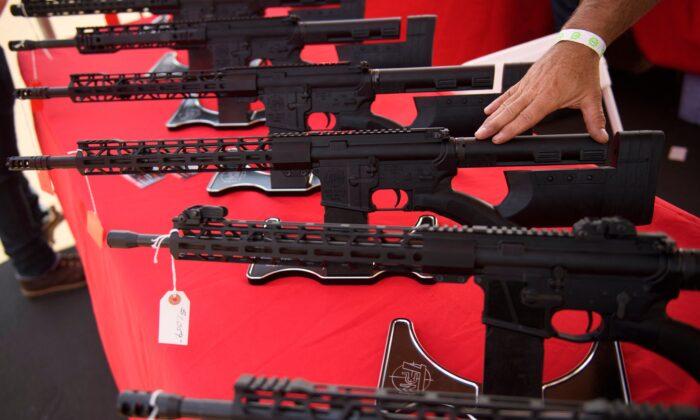Commentary
Gov. Gavin Newsom late last week signed into law seven new
gun-related bills. In sum, they make California’s gun laws, already the strictest in the nation, even more strict.
Senate Bill 264 is by state Sen. Dave Min (D-Irvine). It bans gun shows at the Orange County Fair and Event Center. Newsom’s press office explained, “Gun violence prevention experts warn that gun shows can create a venue to circumvent gun safety laws.” No citations were given.
In fact, according to a 2019 study (
pdf) by the Bureau of Justice Statistics of the U.S. Department of Justice, “Among prisoners who possessed a firearm during their offense, 0.8% obtained it at a gun show.”
And gun shows are already highly regulated in California. Critics say SB 264 will kill about $1 million worth of business and the associated jobs. People still will be able to buy guns at other gun shows, at stores, or in other states. Criminals will still be able to get them on the black market.
Assembly Bill 1191 is by Assemblymember Kevin McCarty (D-Sacramento). It requires the Department of Justice to analyze crime gun data for patterns of illegal possession and trafficking. This actually would be useful to dispel myths of gun use and abuse.
The five remaining bills concern domestic violence and guns.
Two make technical or minor changes to existing domestic violence laws:
Assembly Bill 673 is by Assemblymember Rudy Salas (D-Bakersfield). And
Senate Bill 320 is by Senator Susan Talamantes Eggman (D-Stockton).
Assembly Bill 887 is by Assemblymember Marc Levine (D-Marin County). It allows domestic violence victims to file restraining orders online against alleged perpetrators.
Senate Bill 538 is by state Sen. Susan Rubio (D-Baldwin Park). By July 2, 2022, it requires “a court or court facility that receives petitions for domestic violence restraining orders or gun violence restraining orders to permit those petitions to be filed electronically.”
Opponents say these two bills violate the Fourteenth Amendment right to “due process of law.” As the SEIU union said of SB 538, “Unfortunately, our experience with remote proceedings and appearances during the pandemic has proven that with existing technology, our court reporters’ ability to do their very jobs is all but impossible.”
Assembly Bill 1057 is by Assemblymember Cottie Petrie-Norris (D-Laguna Beach). It concerns so-called “ghost guns,” which can be made or assembled at home, including with parts from 3D printers. According to the Assembly summary, “Includes in the definition of ‘firearm’ a frame, receiver, or precursor part for the purpose of surrender or seizure pursuant to a Gun Violence Restraining Order and a domestic violence restraining order.”
There was no opposition registered to AB 1057. But how does one define “precursor part”? What if a pipe for another purpose is labeled a gun barrel, even if it isn’t? Can anyone with plumbing be arrested?
The Supreme Court and California Gun Laws
The new laws come as the U.S. Supreme Court may take up previous California gun-control restrictions.In June, U.S. District Court Judge Roger Benitez threw out the state’s strict “assault weapons” ban, the Roberti–Roos Assault Weapons Control Act of 1989.
Benitez ruled: “This case is not about extraordinary weapons lying at the outer limits of Second Amendment protection. The banned ‘assault weapons’ are not bazookas, howitzers, or machine guns. Those arms are dangerous and solely useful for military purposes. Instead, the firearms deemed ‘assault weapons’ are fairly ordinary, popular, modern ….
“This is an average case about average guns used in average ways for average purposes. One is to be forgiven if one is persuaded by news media and others that the nation is awash with murderous AR-15 assault rifles. The facts, however, do not support this hyperbole, and facts matter.”
In June the Benitez ruling in the case,
Miller v. Bonta, was stayed by a three-judge panel of the Ninth Circuit Court of Appeals.
In 2008, the U.S. Supreme Court, in the Heller decision, affirmed a personal right to “keep and bear arms.” That is, it’s not just for militias.
California gun-controllers like to say there’s no similar guarantee in the California Constitution. Except that document stipulates in
Article III, Section 1: “The State of California is an inseparable part of the United States of America, and the United States Constitution is the supreme law of the land.” The Constitution includes the Second Amendment.
Columnist Dan Walters noted, “The previous rulings [by Benitez in other gun cases] are making their way through the appellate process and the latest case is headed there as a precursor to a probable showdown in the Supreme Court, which now has a 6-3 conservative majority with recent appointments by former President Donald Trump.”
The court is unpredictable. The decisions, if there are any, would come as murders
jumped 30 percent across the country in 2020. No wonder gun sales soared to 39.7 million nationally that year. That’s on top of an estimated 400 million guns already owned by Americans, more than the population.
The conservatives on the court, at least, are well aware of the need for honest, law-abiding citizens to arm themselves against criminals.





